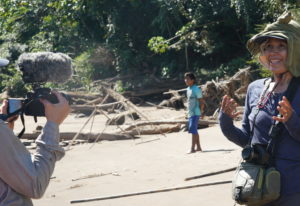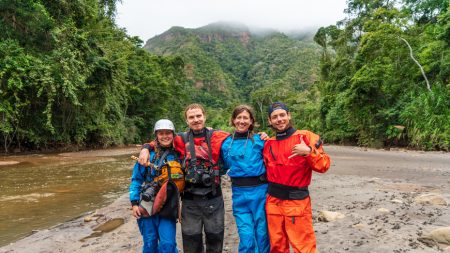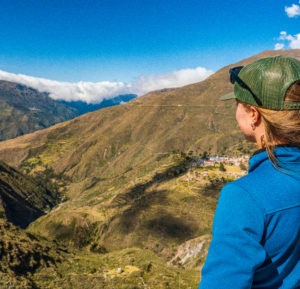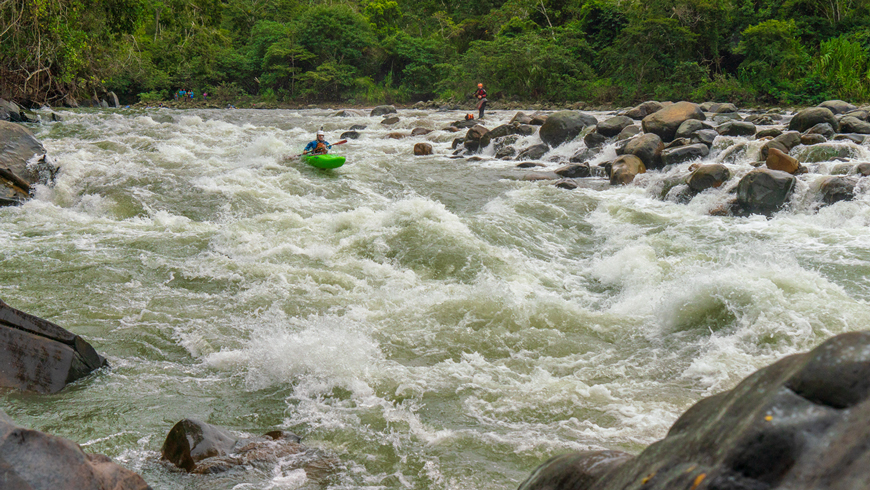
Stuart interviews indigenous peoples advocate Ruth Alipaz Culqui regarding the 12 communities that would be displaced by the proposed Bala Dam.
“If you think of the earth as an organism, rivers are the figurative veins and arteries of our planet.” These were the words of Hayley Stuart, 24, speaking at 2017’s TEDx Sun Valley event. “And just like our blood, the water that flows through rivers serves many purposes: It provides us with fish to eat, and water to drink, to irrigate, to recreate. It keeps our oceans healthy by flushing nutrients down to the coasts to feed coral reefs and coastal life; it regulates regional climates and hydrological cycles; it even sustains forests and ecosystems thousands of miles away. Rivers are so much more than the squiggly lines that you see on maps … They are a coalescence of life itself.”
With the rare combination of a positive attitude and an ability to communicate desperate issues, Stuart effortlessly commanded a packed Sun Valley Opera House with her talk, “Dammed if We Do: A Closer Look at the Dangers of Mega Hydro.”
A Spanish teacher for World Class Academy, a traveling whitewater kayak high school, Stuart calls Sun Valley both home and base camp. In her “free time,” Stuart is a filmmaker, conservation river advocate, and, currently, the project director for the documentary, “Still River, Silent Jungle,” (SRSJ) a female-led whitewater kayaking expedition and film project committed to raising awareness and supporting the protection of the communities and biodiversity within Madidi National Park and Pilon Lajas Cultural Reserve in the Bolivian Amazon. In the final stages of editing, Stuart plans to release the film March 16, 2019.
The project is rooted in Stuart’s own experiences as a student at a traveling kayak high school. Having a knack for blending into her surroundings, Stuart absorbed stories of people and places everywhere she went. Many of the school’s destination rivers, including the Nile in Uganda and the Maipo in Chile, were facing hydropower development projects, both proposed and under construction.
Stuart entered high school with the perception that hydropower was a “green” source of energy generation. However, during her time at the whitewater academy, then during a University of Denver independent study in Chile and a semester abroad in Bolivia, Stuart quickly began to see a rush for global hydropower development. More pointedly, she observed the trend in mega-hydro development of “privatized benefits and socialized costs.”

Members of the expedition and film project include from left: Hayley Stuart, Lorenzo Andrade Astoria, Kira Tenney, and Kalob Grady. Courtesy Hayley Stuart / Kalob Grady
“Not all dams are bad, of course,” noted Stuart in an interview this fall. “But if you look at the rush to construct massive hydro throughout the world, it simply doesn’t make sense … It’s using a now archaic technology as a treatment for symptoms of increased energy demand. Research and countless examples have shown that large-scale hydro has negative social, environmental, and economic repercussions. Take the 30-fold increase in earthquakes in proximate areas since the Three Gorges Dam was built in China, or the uncompensated and displaced farmers from the Bujugali Dam in Uganda, or the massive flooding and deaths that resulted from dams in Bolivia, Colombia, and Laos recently. In many examples, people are told they’ll get power and then the price is such that it goes to large-scale industrial projects, while local people remain in the dark.”
The catalyst for “Still River, Silent Jungle” was Stuart’s semester abroad with the School for International Training (SIT) in Bolivia in 2014. In one of her classes, she learned about multiple mega-hydro projects that to her did not add up in terms of widespread benefit and long-term gain. The high-sediment nature of the rivers, the effective flooding of extremely biodiverse areas, and the displacement of many Amazonian indigenous groups—some of whom remain “untouched,” that is, living in the jungle without ever having any known outside contact—made for an incomplete allocation of costs and benefits of the large-scale hydro plans. For years, she continued to follow up on the developments and then zeroed in on the proposed Bala-Chepete dams, which are set to drastically impact Madidi National Park, recently noted by The New York Times as being perhaps the most biodiverse park in the world.
What began as a single self-support kayak trip and film capturing the stories of the local people who would be displaced by the dams and the biodiversity that would be lost quickly snowballed into an interdisciplinary documentary film project comprising multiple expeditions. May through June 2018, Stuart compiled a team of international whitewater kayakers, the director and park rangers of Madidi National Park, local mining representatives from riverside indigenous communities, local ecotourism guides, and Ruth Alipaz Cuqui, an environmental and indigenous peoples activist. Ultimately, the team was set to meet for the first time to raft and kayak the Tuichi River, the main artery of Madidi National Park.
Everyone got more than they bargained for. After the trip, Kalob Grady, professional kayaker and head coach at World Class Academy, said, “Being involved in this project with Hayley was as humbling as it was rewarding. Our team represented four different nationalities and very different backgrounds, which was simply amazing to learn from each other and, ultimately … all learn from the river. There are always setbacks—flash floods, airline gear shutdowns, things literally lost in translation—but Hayley always motivated and maneuvered positive ways forward. And having the opportunity to see and learn from the people who call the Tuichi home was incredible. No doubt, this opportunity for all of us and the momentum forward with “Still River, Silent Jungle” comes from Hayley just being so driven by her passion.”

After traversing the snow-capped Royal Mountain Range, Stuart looks down at the winding roads that plunge down into the Amazon and the put-in of the Tuichi River.
Part of the Tuichi expedition was dedicated to training national park guards in river rafting. This will have an immense impact, as one of the Madidi park rangers’ primary patrols for monitoring illegal logging, mining, and poaching takes 19 days trekking through the jungle. Going by river, they can cover the same terrain in five days.
The team also explored and revealed Bolivia’s great potential for adventure and whitewater ecotourism as an alternative path to economic development that would be sustainable and beneficial for local populations. Conversely, they saw firsthand what the losses would be to the local inhabitants, as well as to the world community, if the proposed hydropower projects move forward.
“This mentality of building so many dams is like saying that everyone around the world should go through the same progression of cell phones that we went through, instead of just jumping to current technology,” Stuart explained. “In the case of energy, there are such better alternatives now… solar, wind, and geothermal. And widespread research supports that smaller, local systems hold more relevance and benefits for the long term. Basically, we don’t need to start everyone on flip phones with 1G service. As seen in the U.S., we are now working to take dams out. There are many ways to generate electricity and many ways to develop nations responsibly, but the best way to protect the rivers that hold our most cherished resources is to keep them free-flowing.”


